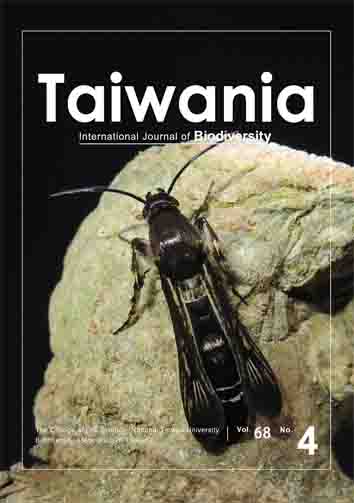Note
Temperature and salinity variation in oscular tubes of the branching sponge Haliclona sp. inhabiting a tidal pool influenced by fresh groundwater discharge in Taiwan
Yalan Chou, Chih-Hsien Chang, Li-lian Liu
Published on: 12 November 2023
Page: 480 - 483
DOI: 10.6165/tai.2023.68.480
Abstract
This study recorded temperature and salinity in oscular tubes of the branching sponge (Haliclona sp.) living in an intertidal coral reef with fresh groundwater inflow on Green Island, Taiwan. During the ebb tide period, seawater temperature and salinity around the sponges ranged from 30.6 to 34.1°C and 17 to 27‰, respectively. The temperature and salinity within sponge oscular tubes were 30.8 - 34.5°C and 23 - 27‰, respectively. The oscular openings usually had higher salinity than ambient waters near the fresh groundwater inflow. Some of the largest differences in salinity between the sponge oscular tube and ambient seawater were in the range of 6 - 8‰. The sponges regularly experienced wide fluctuations in salinity (4 - 28‰) and temperature (23.2 - 34.8°C) for at least 3 hours during ebb tide periods. Whether the ostia play a role in actively maintaining the internal salinity of the branching Haliclona sponges needs further investigation.
Keyword: Fresh groundwater, oscular tube, sponge, salinity, temperature
Literature Cited
Duckworth, A.R., West, L., Vansach, T., Stubler, A., Hardt, M. 2012 Effects of water temperature and pH on growth and metabolite biosynthesis of coral reef sponges. Mar. Eco. Prog. Ser. 462: 67?77.
DOI: 10.3354/meps09853View Article
Google Scholar
Fell, P.E., Knight, P.A., Rieders, W. 1989 Low-salinity tolerance of and salinity-induced dormancy in the estuarine sponge Microciona prolifera (Ellis et Solander) under long-term laboratory culture. J. Exp. Mar. Biol. Ecol. 133(3): 195–211.
DOI: 10.1016/0022-0981(89)90045-2View Article
Google Scholar
Hartman, W.D. 1958 Natural history of the marine sponges of southern New England. Bull. Peabody Mus. Nat. Hist. 12: 1–155.
Knight, P.A., Fell, P.E. 1987 Low salinity induces reversible tissue regression in the estuarine sponge Microciona prolifera (Ellis and Solander). J. Exp. Mar. Biol. Ecol. 107(3): 253–261.
DOI: 10.1016/0022-0981(87)90042-6View Article
Google Scholar
La Valle, F.F., Kantar, M.B., Nelson, C.E. 2021 Coral reef benthic community structure is associated with the spatiotemporal dynamics of submarine groundwater discharge chemistry. Limnol. Oceanogr. 66(1): 188–200.
DOI: 10.1002/lno.11596View Article
Google Scholar
Lopez-Legentil, S., Song, B., McMurray, S.E., Pawlik, J.R. 2008 Bleaching and stress in coral reef ecosystems: hsp70 expression by the giant barrel sponge Xestospongia muta. Mol. Ecol. 17(7): 1840–1849.
DOI: 10.1111/j.1365-294X.2008.03667.xView Article
Google Scholar
Reiswig, H.M. 1971 In-situ pumping activities of tropical Demospongiae. Mar. Biol. 9(1): 38–50.
DOI: 10.1007/BF00348816View Article
Google Scholar
Santos, R.O., Lirman, D., Serafy, J.E. 2011 Quantifying freshwater-induced fragmentation of submerged aquatic vegetation communities using a multi-scale landscape ecology approach. Mar. Eco. Prog. Ser. 427: 233–246.
DOI: 10.3354/meps08996View Article
Google Scholar
Sims, Z.C., Cohen, A.L., Luu, V.H., Wang, X.T., Sigman, D.M. 2020 Uptake of groundwater nitrogen by a near-shore coral reef community on Bermuda. Coral Reefs, 39(1): 215–228.
DOI: 10.1007/s00338-019-01879-5View Article
Google Scholar
Singh, A., Thakur, N.L., Sheikh, F. 2022 Differential tolerance capacity of intertidal organisms (sponge and zoanthid) to the environmental stresses: Preliminary Bndings from a rockpool transplantation experiment. J. Earth Syst. Sci. 131(1): 1.
DOI: 10.1007/s12040-021-01739-3View Article
Google Scholar


